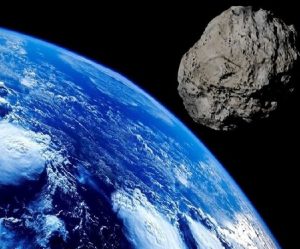 New Delhi : A large asteroid, 1998 OR2, will safely fly by within 6.3 million kilometers of Earth on Wednesday, and scientists have stressed that it poses no danger to Earth. The 2-kilometer-wide asteroid passing by the Earth will provide astronomers with an exceptional opportunity to study the object in great detail.
New Delhi : A large asteroid, 1998 OR2, will safely fly by within 6.3 million kilometers of Earth on Wednesday, and scientists have stressed that it poses no danger to Earth. The 2-kilometer-wide asteroid passing by the Earth will provide astronomers with an exceptional opportunity to study the object in great detail.
Scientists have reiterated that there is no need to panic as there is zero chance that the asteroid will hit Earth during the flyby. The object will fly 16 times further than the distance to the Moon and although it seems like a close shave in the context of the visible universe the distance is over 90 billion light-years. It is to be noted that the moon orbits Earth at an average distance of 385,000 km.
What is the 1998 OR2 asteroid?
The 1998 OR2 asteroid is 1.5-mile-wide (2-kilometer-wide) and will get no closer than about 3.9 million miles (6.3 million kilometers), passing more than 16 times farther away than the Moon. The asteroid will make its closest approach at 5:55 a.m. EDT (2:55 a.m. PDT). While this is known as a “close approach” by astronomers, it’s still very far away.
“The small-scale topographic features such as hills and ridges on one end of asteroid 1998 OR2 are fascinating scientifically. But since we are all thinking about Covid-19 these features make it look like 1998 OR2 remembered to wear a mask,” said Dr Anne Virkki, head of planetary radar at the observatory.
Since they are bigger, asteroids of this size reflect much more light than smaller asteroids and are therefore easier to detect with telescopes. Almost all near-Earth asteroids (about 98%) of the size of 1998 OR2 or larger have already been discovered, tracked and cataloged. It is extremely unlikely there could be an impact over the next century by one of these large asteroids, but efforts to discover all asteroids that could pose an impact hazard to Earth continue.
When was it discovered?
Asteroid 1998 OR2 was discovered by the Near-Earth Asteroid Tracking program at NASA’s Jet Propulsion Laboratory in July 1998, and for the past two decades, astronomers in Arecibo Observatory in Puerto Rico have tracked it.
The asteroid will get no closer than about 3.9 million miles (6.3 million kilometers), passing more than 16 times farther away than the Moon.
When will be the closest approach of the asteroid to Earth?
The asteroid will make its closest approach at 5:55 a.m. EDT (2:55 a.m. PDT).
When will the next close approach of the asteroid to Earth?
NASA said, “We understand its orbital trajectory very precisely, and we can say with confidence that this asteroid poses no possibility of impact for at least the next 200 years. Its next close approach to Earth will occur in 2079 when it will pass by closer — only about four times the lunar distance.”
What is a potentially hazardous asteroid?
Potentially Hazardous Asteroids (PHAs) are currently defined based on parameters that measure the asteroid’s potential to make threatening close approaches to the Earth. Specifically, all asteroids with an Earth Minimum Orbit Intersection Distance (MOID) of 0.05 au or less and an absolute magnitude (H) of 22.0 or less are considered PHAs. In other words, asteroids that can’t get any closer to the Earth (i.e., MOID) than 0.05 au (roughly 7,480,000 km or 4,650,000 mi) or are smaller than about 140 m (~500 ft) in diameter (i.e., H = 22.0 with an assumed albedo of 14%) is not considered PHAs.
Why has it been termed as a potentially hazardous asteroid?
Despite this, 1998 OR2 is still categorized as a large “potentially hazardous asteroid” because, over the course of millennia, very slight changes in the asteroid’s orbit may cause it to present more of a hazard to Earth than it does now. This is one of the reasons why tracking this asteroid during its close approach — using telescopes and especially ground-based radar — is important, as observations such as these will enable an even better long-term assessment of the hazard presented by this asteroid.
When did the last asteroid flyby Earth?
Close approaches by large asteroids like 1998 OR2 are quite rare. The previous close approach by a large asteroid was made by asteroid Florence in September 2017. That 3-mile-wide (5-kilometer-wide) object zoomed past Earth at 18 lunar distances. On average, we expect asteroids of this size to fly by our planet this close roughly once every five years.
NASA claims to have found and tracked more than 90% of the near-Earth asteroids (NEAs) that are least 0.6 miles (1 km) wide and are big enough to cause heavy damage if they hit the Earth’s surface. NASA’s Planetary Defense Officer and program executive of the Planetary Defense Coordination Office, however, told Space.com that such relief should not breed complacency.
Bureau Report
Leave a Reply